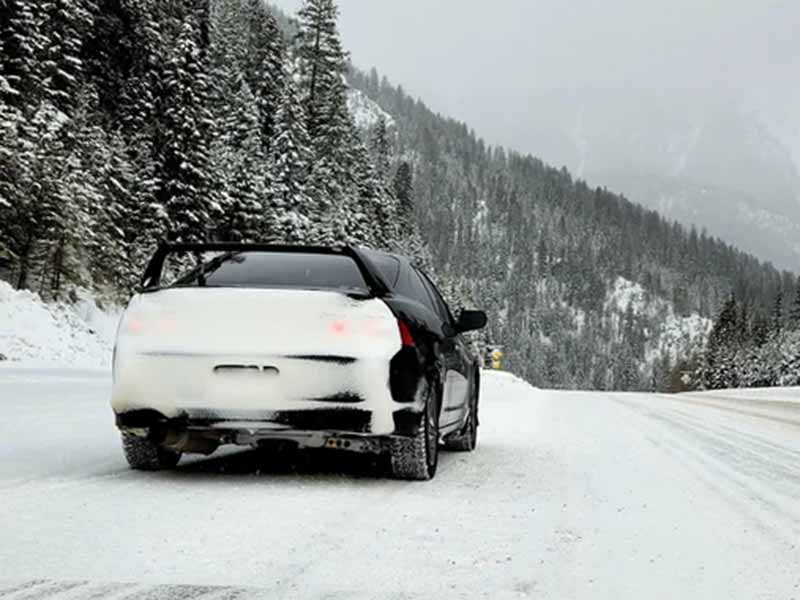Have you ever wondered how long studded tires last and if they’re truly worth the investment? If you’re someone who faces icy roads and harsh winter conditions, understanding the lifespan and value of studded tires is key.
How Long Do Studded Tires Last?
Studded tires can last up to 4 to 5 seasons or approximately 30,000 to 40,000 miles when used primarily on icy and heavy snow conditions.
However, their lifespan significantly reduces to about 2 to 3 seasons or around 15,000 to 25,000 miles with substantial usage on dry pavement.
In this article, we delve into the essential aspects of studded tires, including their design, lifespan, advantages and disadvantages, comparison with other winter tires, and performance on different pavements.
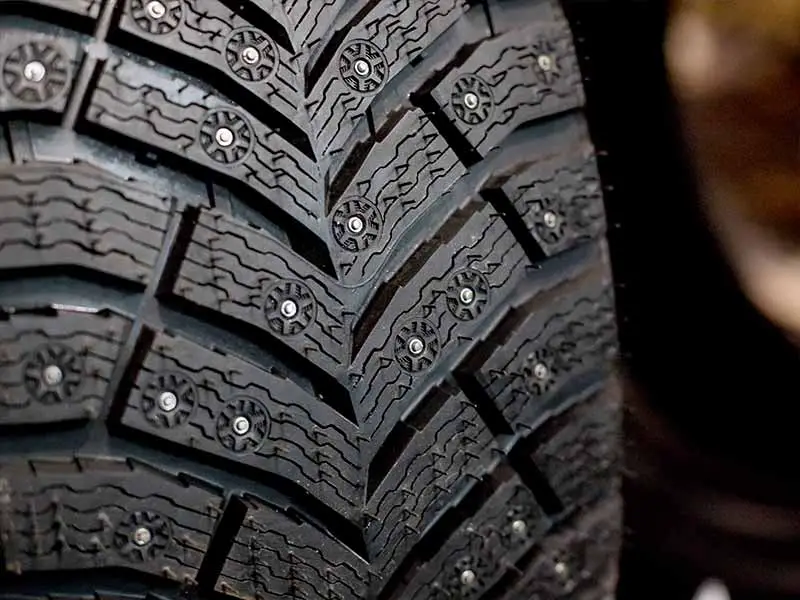
Lifespan of Studded Snow Tires
The lifespan of studded tires is influenced by various factors, including usage, care, and driving conditions. It’s not just about how long they last, but also about getting the most value and safety out of them.
Factors Affecting Lifespan
The lifespan of studded tires can vary based on several factors. Here are the key ones:
- Driving Habits: How you drive can affect how long your tires last. Aggressive driving wears tires out faster.
- Road Conditions: Driving on rough or dry roads can wear out the studs quicker.
- Maintenance: Regular checks and proper tire care can extend their life.
- Storage: How and where you store these tires when not in use also matters.
Average Lifespan
On average, studded tires can last anywhere from four to five seasons. But this depends a lot on how often you use them and the conditions you drive in. If you only use them in severe winter conditions and take good care of them, they can last longer.
Comparing with Regular Winter Tires
Studded tires generally have a similar lifespan to regular winter tires. However, the studs can wear down over time, especially if used on dry pavement. When the studs wear down, the tire’s ability to grip ice decreases.
Tips for Extending Lifespan
To get the most out of your studded tires, consider these tips:
- Use Only in Winter: Only use studded tires in winter conditions. Using them on dry roads can wear down the studs quickly.
- Drive Carefully: Avoid aggressive driving habits like fast starts and stops.
- Regular Checks: Regularly check the tire pressure and the condition of the studs.
- Proper Storage: Store them in a cool, dry place away from direct sunlight when not in use.

Pros and Cons of Studded Winter Tires
Studded tires offer significant benefits in terms of safety and traction in icy conditions, but they also come with drawbacks like road damage and noise. It’s important to weigh these pros and cons carefully to decide if they’re the right choice for your winter driving needs.
Advantages of Studded Snow Tires
Studded snow tires offer specific benefits, especially in harsh winter conditions:
- Enhanced Traction on Ice: The metal studs provide superior grip on icy surfaces, reducing the risk of skidding.
- Improved Safety: In regions with severe ice and snow, studded snow tires can significantly improve safety by enhancing control and reducing stopping distances.
- Reliability in Extreme Conditions: For those living in areas with frequent ice storms or extremely cold temperatures, studded tires can be a reliable option.
Disadvantages of Studded Snow Tires
However, there are also some downsides to consider:
- Road Damage: The metal studs can damage road surfaces, especially when there’s no ice or snow.
- Noise: Studded snow tires tend to be noisier than regular tires, which can be a discomfort for some drivers.
- Limited Usage Period: Many regions have restrictions on when studded winter tires can be used, usually limited to the winter months.
- Cost: They can be more expensive than standard winter tires, both in initial cost and potential for increased fuel consumption due to higher rolling resistance.
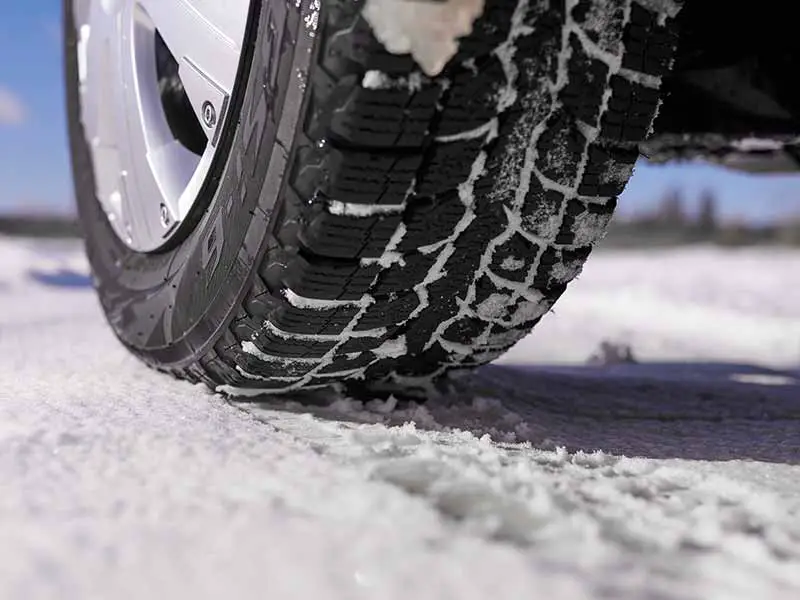
Studded Winter Tires vs. Average Winter Tires
While studded tires offer unmatched performance in icy conditions, their use is specific and may not be necessary for all winter drivers. Studless snow tires provide a good alternative with their own advantages.
Studded Tires vs. Studless Snow Tires
Let’s look at how studded tires stack up against their studless counterparts:
- Traction on Ice: Studded tires generally offer better traction on ice due to their metal studs. Studless snow tires, while effective, may not provide the same level of grip in extreme icy conditions.
- Road Impact: Studless tires are gentler on road surfaces, as they don’t have metal studs that can cause wear and tear.
- Noise Level: Studless tires are quieter compared to the noticeable noise generated by studded tires.
- Flexibility in Use: Studless snow tires can be used in a wider range of winter conditions without the legal restrictions often associated with studded tires.
Studded Tires vs. Regular Winter Tires
Comparing studded tires with regular winter tires:
- Extreme Conditions: Studded tires are more effective in extreme winter conditions, particularly on hard-packed snow and ice.
- Versatility: Regular winter tires are more versatile for varying winter conditions and are suitable for a broader range of winter scenarios.
- Cost and Maintenance: Regular winter tires might be more cost-effective in the long run, considering the maintenance and specific usage conditions of studded tires.
For a deeper understanding of winter tires and their features, I recommend reading about What Are Winter Tires. This will provide you with comprehensive information to help in your decision-making process.
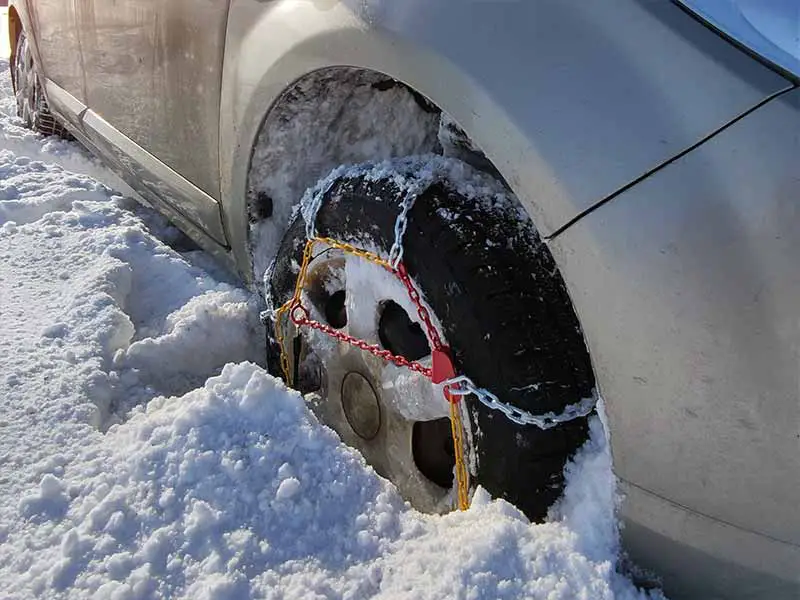
Studded Tires vs. Chains
The choice between studded tires and chains largely depends on the frequency and severity of winter conditions you face, as well as the legal regulations in your area.
Let’s break down the key differences and considerations.
Understanding the Differences
Studded tires and chains serve a similar purpose but in different ways:
- Studded Tires: These are tires with metal studs embedded in them. They provide continuous traction and are ideal for consistent icy road conditions.
- Chains: Tire chains are metal links fitted over the tire’s tread. They are used temporarily and offer excellent grip on snow and ice.
When to Use Studded Tires
Studded tires are a good choice when:
- Consistent Winter Conditions: If you live in an area with prolonged periods of ice and snow.
- Regular Winter Driving: For those who need to drive daily in winter conditions.
- Road Safety: In regions where icy roads are a common safety concern.
When to Use Chains
Chains are more suitable in certain situations:
- Occasional Use: Ideal for occasional trips through snowy or icy terrain.
- Emergency Situations: Useful as a temporary solution for unexpected winter weather.
- Flexibility: They can be put on and taken off as needed, offering flexibility.
Safety and Convenience
Both options have their safety and convenience factors:
- Studded Tires: Offer a more convenient, set-it-and-forget-it solution for the entire winter season.
- Chains: Require physical effort to install and remove, which can be challenging in cold and snowy conditions.
Legal Considerations
It’s important to consider the legal aspects:
- Studded Tires: Some regions restrict or prohibit the use of studded tires due to road damage concerns.
- Chains: Often allowed in most regions, especially during severe weather conditions, but may have usage restrictions.
For more detailed insights into this comparison, you can explore the topic further on Studded Tires vs Chains.

Studded Tires on Different Pavements
Studded tires offer unmatched performance on icy and snowy roads but are less suitable for dry pavement due to increased wear and potential road damage.
Performance on Icy and Snowy Roads
Studded tires are specifically designed for icy and snowy conditions:
- Ice: The metal studs in these tires bite into the ice, providing excellent traction and reducing the risk of skidding.
- Snow: They also perform well on snow-covered roads, helping maintain control and stability.
Impact on Dry Pavement
However, the performance of studded tires on dry pavement is a different story:
- Wear and Tear: The studs can wear down more quickly on dry roads, reducing their effectiveness in ice and snow.
- Road Damage: Continuous use on dry pavement can lead to road damage due to the abrasive nature of the studs.
- Noise and Comfort: Drivers often notice increased noise and a rougher ride when using studded tires on dry roads.
Legal Restrictions
It’s important to be aware of legal restrictions regarding studded tires:
- Seasonal Limitations: Many regions restrict the use of studded tires to certain months, typically the winter season.
- Complete Prohibition: In some areas, studded tires are completely illegal due to the potential road damage they can cause.
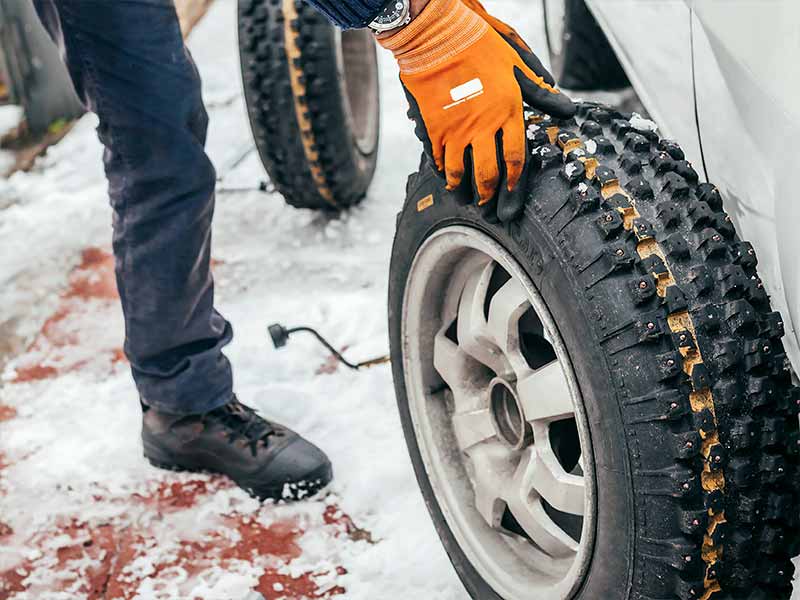
Are Studded Tires Worth It?
While studded tires offer unparalleled performance on ice, the cost, noise, and legal restrictions are important factors to consider.
Let’s explore whether studded tires are a worthwhile investment for your winter driving needs.
Evaluating the Cost-Benefit
When considering studded tires, it’s essential to weigh their costs against the benefits:
- Safety: The primary benefit of studded tires is enhanced safety in icy conditions. If you frequently encounter ice-covered roads, the safety advantage can be significant.
- Cost: Studded tires can be more expensive than regular winter tires. There’s also the potential added cost of having two sets of tires for different seasons.
Personal and Regional Considerations
Your decision should also factor in personal and regional aspects:
- Driving Conditions: If you live in an area with severe winters and icy roads, studded tires can offer peace of mind and improved safety.
- Legal Restrictions: Be aware of the laws in your area regarding studded tires. If their use is heavily restricted, they might not be a practical choice.
- Comfort and Noise: Consider your tolerance for the increased noise and different driving feel that studded tires can bring.
Long-Term Value
Think about the long-term value of studded tires:
- Durability: If maintained properly, studded tires can last through several winter seasons, which can enhance their value over time.
- Resale Value: In areas where studded tires are in high demand, they may retain a good resale value.
Making the Right Choice
Ultimately, deciding if studded tires are worth it comes down to a balance of safety, cost, and practicality:
- Safety vs. Cost: If safety in extreme winter conditions is your top priority, the investment in studded tires might be justified.
- Frequency of Use: Consider how often you’ll realistically need the enhanced traction of studded tires.
- Alternatives: Evaluate if other types of winter tires could meet your needs without the additional cost and restrictions of studded tires.
Resources
Below are some links you may find helpful when learning about tires:
- Winter driving tips – National Highway Traffic Safety Administration
- What are winter tire studs – Tire Buyer
Final Thoughts
Studded tires are a specialized choice for winter driving, offering unmatched traction on icy surfaces. However, their suitability largely depends on your specific driving conditions, regional weather patterns, and legal regulations.
While they excel in providing safety and control on ice-covered roads, the potential accelerated wear on dry roads, noise, and cost are important factors to consider.
The decision to use studded tires should be based on a careful assessment of your winter driving needs and the typical conditions you encounter.
Good luck and happy motoring.
